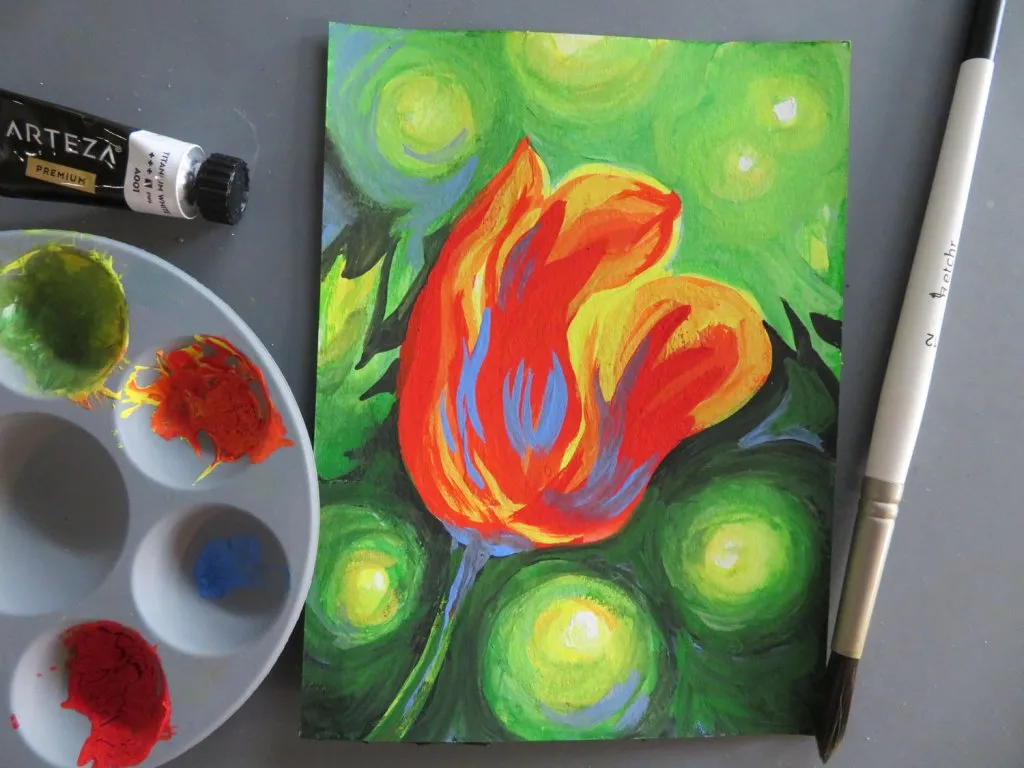Gouache Paint: History, Characteristics, and Creative Uses

Gouache Paint: History, Characteristics, and Creative Uses
Gouache is an aqueous middle-range hue that is well-loved by artists and continues to enjoy a wide appeal to this day. Initially employed in France in the eighteenth century. Gouache paint is universally well-loved for its subtle properties and cannot be left unnoticed by amateurs and professionals. So, in this article let’s go more into the details about what this paint is. Where it came from and where it goes, what makes gouache so special. How you can use it in your art, as well as some useful tips and tricks about this wonderful type of paint.
What is Gouache?
Gouache (voiced gw-ash) is a water-medium paint that includes natural pigment, water, a binder that is the gum Arabic, and in some cases a filler. However, while it is similar to watercolor, This brand of paint is opaque because it contains whiting, which is a kind of chalk. This opacity facilitates artists to develop bright/opaque, solid areas with color. Which are ideal for clear illustrations explainers, and lively designs.
The History of Gouache
The French term gouache became popular in the eighteenth century. In its early days, it was a form of paint where the pigments were mixed with water-soluble gum just as in the watercolors but included a white color to make it a bit thicker a s well. This provi{sion} of distinct types of support granted artists the possibility of attaining brilliance and depth in their pieces, which in turn contributed to the popularity of this technique.
Gouache vs. Other Paints
It pays to give emphasis on art materials that one can use while painting because gouache paint is quite different from other forms of painting tools. Here’s a quick comparison:
| Feature | Gouache | Watercolor | Acrylic |
|---|---|---|---|
| Opacity | Opaque | Transparent | Opaque |
| Binder | Gum arabic | Gum arabic | Acrylic polymer |
| Drying Time | Quick | Quick | Variable |
| Re-wettable | Yes | Yes | No |
| Finish | Matte | Transparent/glossy | Glossy/matte |
The Characteristics of Gouache
Opacity and Coverage
This paint is also known to be very opaque and this is one of the major merits of using gouache paint. This allows artists to layer colors without the previous layers showing through, providing excellent coverage. It’s particularly useful for creating solid blocks of color and fine details in illustrations.
Vibrancy
When it comes to the defining attributes of this technique, one should mention the following: the rich and varied colors of the paint. Another key difference between gouache and watercolor is that the pigments used in the creation of the paint are usually of high quality and with a very fine grind, thus rendering vibrant, loud hues. Many water-soluble brands, such as Daler-Rownley Simply Gouache, offer a wide variation in tints so that the paints are not restricted in this respect when it comes to being used from the tube.
Versatility
What is perhaps fascinating with gouache painting is the fact that it always comes out great&emdash; no matter how it is applied. can be improved for use on paper, wood, and canvas. Due to its re-wettability characteristic, it can be moistened with water when dry and the drying time is quite long unlike the acrylics and this means artists can alter dried paint with water thus facilitating in erasing error-prone paintings.
How to Use Gouache: A Step-by-Step Guide
Materials Needed
To get started with paint, you’ll need:
- Gouache paint tubes
- Brushes (variety of sizes)
- Palette
- Water container
- Paper (preferably thick watercolor paper)
- Mixing palette
Setting Up Your Workspace
- Prepare your palette: Dip your brush into the gouache paint and remove some small portion of the paint by wiping it on your palette.
- Get your brushes ready: Apart from the shape, make sure that you also have brushes of different sizes so that when painting details you do not have to switch brushes frequently.
- Fill a container with water: Used to wash your brushes and thin your paint where necessary.
- Arrange your paper: After writing your paper, it is important to secure the paper flat to avoid it getting wrinkled or forming some kind of curl.
Basic Techniques
- Mixing Colors: In this step use your palette and try to mix the various colors. One important aspect that should be noted is that paint can be applied mixed in the same way as watercolor or acrylic.
- Layering: If in the first stage, you decided on light colors, in the second you should paint just darker ones.
- Dry Brushing: For texture, use a dry brush technique. Paint a little skinny wash by dipping the bristles of your brush into the paint. Not water before painting the paper.
- Blending: Wipe the brush clean using a rag and paint in one shade at a time, so as to create seamless blends.
Tips for Beginners
- Practice: Experiment with different techniques and color mixes.
- Use water sparingly: Excess liquid in the paint can cause it to resemble watercolor and lack its covering power.
- Keep brushes clean: Avoid color contamination by washing brushes more often as this prevents colors from mixing up.
- Work quickly: This paint is rather a fast setting, and that means it is best to act quickly when applying it.
Advanced Techniques and Tips
Wet on Wet
This technique involves applying wet paint onto a wet surface, creating soft edges and gradients. It’s great for backgrounds and atmospheric effects.
Dry Brushing for Texture
Some of those include applying gouache, color washing with thin layers, applying gouache, and creating dried brush effects. Take a dry brush and dip it into the gouache paint directly without diluting. Draws it across the paper surface to achieve an uneven, textured finish.
Lifting
As you might know gouache is not a paint that loses its workability once dried. It can be reactivated with water.
Popular Gouache Brands
Daler-Rowney Simply Gouache
Independent of other gouache brands Simply Gouache is one more high-quality product from Daler-Rowney that features fine rich covering and sundry colours. These paints are highly portable and can be applied in their pure form for morecivilations choices of colors are virtually countless. They are ideal for learners who are beginning CVs for the first time as well as those who have spent years practicing the art.
Winsor & Newton Designers Gouache
The Winsor & Newton Designers Gouache is another well-recognized brand found in the market. Because of high light fastness, brilliant Hue, and the characteristics of the influences of the different tints. It has an enormous range of colors, and it is a go-to choice among professional illustrators and designers.
Holbein Artists’ Gouache
The Holbein Artists’ Gouache specifically has many benefits, including its apparently smooth and creamy mouthfeel and high cover. Concerning the colors, this brand has the full spectrum with other individual color options not available in other brand.
FAQs About Gouache
What is gouache used for?
Gouache is used in illustration, fine, art, and designs among other forms of artwork. It has a flexible nature for use. It is transparent allowing for detailed work, creating vibrant illustrations, and really using a shade or tint as a block of color.
Can gouache be mixed with other mediums?
Yes, This paint can be washed up with watercolor to achieve different outcomes as compared to a normal watercolor wash. But, if it is mixed with acrylics it may possibly affect the re-wettableness of the heavy metal pigment.
How do you store gouache paintings?
There are individual characteristics that should also be taken note of especially when it comes to storage.
Gouache paintings should be stored flat and away from light since bright lights might lead to fading. It is ideal to cover them with glass to avoid dust and damage to their surface by any accident.
Can you use gouache on canvas?
Yes, This paint can be used on canvas. But usually, it is used on paper with the paper chosen according to the technique. If the application is on canvas then it is best that the canvas is smooth for best results.
Is gouache toxic?
Gouache painting is safe for most artists since most paints are Nontoxic Still, it is advisable to check on the manufacturer label for any pigment that is a particular worry to the artist.
Conclusion
Gouache is one of the most interesting mediums that can be used by artists because it brings together the high-quality situations of watercolor and acrylic while also providing a good deal of versatility, brightness, and precision. It does not whether you use ” gouache gouache ” to start exploring different styles related to art. If you are an experienced artist working to diversify your portfolio. The medium is useful. This paint is a versatile tool that can be mastered by practice and application. The following shall offer more insight into its use.
You find a way to unleash your creativity. Create whatever your imagination can envision by taking a look at the wonderful world of gouache.







